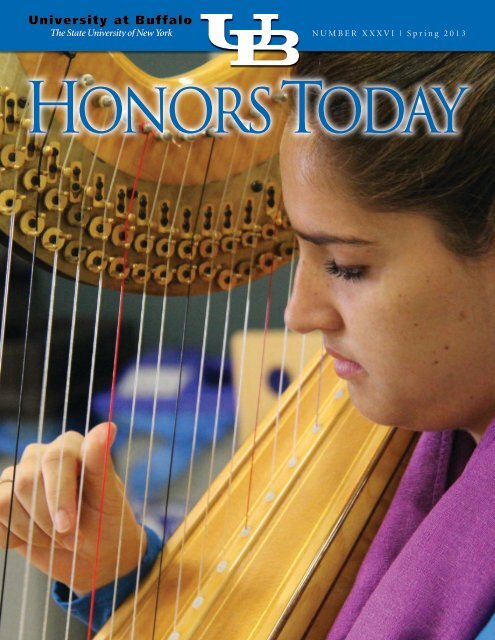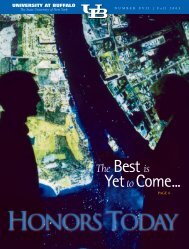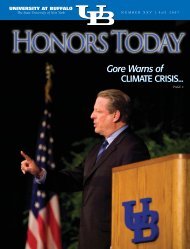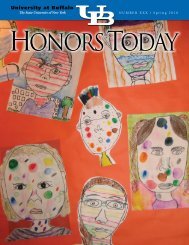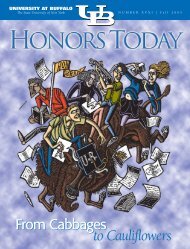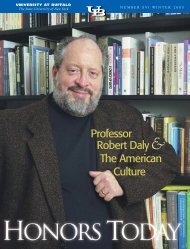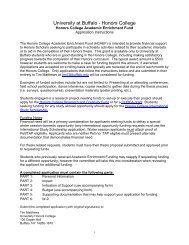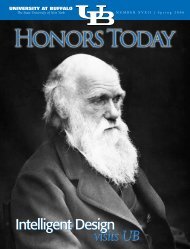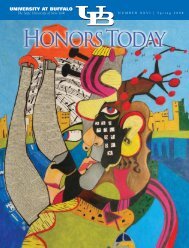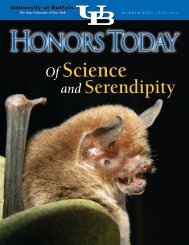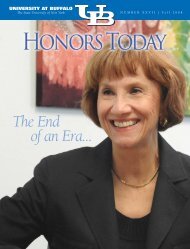Spring 2013 - University Honors College - University at Buffalo
Spring 2013 - University Honors College - University at Buffalo
Spring 2013 - University Honors College - University at Buffalo
- No tags were found...
Create successful ePaper yourself
Turn your PDF publications into a flip-book with our unique Google optimized e-Paper software.
I Am HospiceBethany (Arber) Calkins<strong>Honors</strong> Scholar, Class of 2003Harvey MacKay once said, “Find something youlove to do and you’ll never have to work a dayin your life.” There aren’t too many people inmy personal life who love wh<strong>at</strong> they do, and I’massuming th<strong>at</strong> this trend transl<strong>at</strong>es to the generalpopul<strong>at</strong>ion. I, however, am the exception. I lovewh<strong>at</strong> I do. I am a board certified hospice andpalli<strong>at</strong>ive medicine physician.Anyone who has lost a loved one knows th<strong>at</strong> thereare no more painful days than those surroundingtheir de<strong>at</strong>h. Family members are exhausted fromthe long journey leading up to this time; therehave been sleepless nights punctu<strong>at</strong>ed by fearand anxiety, and days as long as any lived before.P<strong>at</strong>ients are often in and out of hospitals anddoctors’ offices for months on end, receivingdebilit<strong>at</strong>ing tre<strong>at</strong>ments, waiting long hours forappointments, and <strong>at</strong>tempting to process andintegr<strong>at</strong>e inform<strong>at</strong>ion about their disease, theirprognosis, and their medic<strong>at</strong>ions. They oftenreceive conflicting inform<strong>at</strong>ion from differenthealth care providers and undergo an exhaustiveschedule of interviews with clerks, nurses, trainees,physicians, and consultants and all in the settingof an already exhausted mind and body th<strong>at</strong> isno longer functioning <strong>at</strong> 100%. After all of theirstruggles, some hear wh<strong>at</strong> they perceive as theworst news of their life: “There is nothing more wecan do.”My work in hospice begins when people feel theyhave nowhere to turn. My colleagues and I arethe answer to “there is nothing more we can do.”Our stance is th<strong>at</strong> there is always more to do.Symptoms can be amelior<strong>at</strong>ed, taboo topics canbe broached, and hopes and goals can change,usually from quantity of life to quality of life.Hospice p<strong>at</strong>ients and their families benefit froman array of services, including top notch medicalcare, chaplaincy, social work, massage therapy,music therapy, child life and bereavement services.Our field has expounded on the idea of theinterdisciplinary team, as we all work together toensure quality in our p<strong>at</strong>ients’ days.There are times when I listen to my p<strong>at</strong>ients’stories in awe of all they’ve been through andaccomplished in their lives. War stories, love6u n i v e r s i t y a t B U F F A L o
stories, stories of persecution and of courage inthe face of defe<strong>at</strong> are prevalent in everyday people.Wh<strong>at</strong> my p<strong>at</strong>ients don’t know, however, is th<strong>at</strong> Iconsider the stories th<strong>at</strong> they share with me on adaily basis to be gifts; lessons learned, rel<strong>at</strong>ionshipscherished, and history lived.When I think of how I came to Hospice, I believeth<strong>at</strong> my story, both personally and professionally,began as the daughter of a volunteer firefighter.He would often take me to his first aid classes,mostly because there was no babysitter. I tookmy Barbie dolls and played quietly on the floorin the back of the room. Some of my dad’sfavorite stories are of when, <strong>at</strong> seven years old,my head would pop up in the backof the room to answerquestions for theinstructor th<strong>at</strong> no oneelse could (“The ABCsare Airway, Bre<strong>at</strong>hing,and Circul<strong>at</strong>ion”). Ialso joined him onhis first aid calls,where I would w<strong>at</strong>chthe p<strong>at</strong>ient loadedinto the ambulanceand try to guessthe affliction. Ruleswere, though, th<strong>at</strong> Iwasn’t allowed out ofthe car (th<strong>at</strong> rule wasoften broken as veteranfirefighters allowed meout and to the sidewalkto monitor the goings-on).On one infamous camping tripwith my f<strong>at</strong>her, lunch was cut short tofollow a fire truck to its final destin<strong>at</strong>ion. Clearly,medicine was right for me.Fast forward to my last year of high school, when Iapplied for and was accepted into a new programth<strong>at</strong> allowed fifteen seniors into a hospital toobserve all areas of medicine. By seventeen yearsold, I was w<strong>at</strong>ching hysterectomies and roundingwith <strong>at</strong>tendings. This experience paved the wayfor admission to the <strong>University</strong> <strong>at</strong> <strong>Buffalo</strong>, where Iwas invited to join the Advanced <strong>Honors</strong> Programafter my second year. Here, I was encouragedto cre<strong>at</strong>e my own degree in the An<strong>at</strong>omical andP<strong>at</strong>hological Sciences (following detours throughthe schools of nursing and medical technology).Independent study time allowed me to develop myskills in the an<strong>at</strong>omy lab and taught me to workhard to reach my goals.I can see now th<strong>at</strong> there was more than onelaunching pad to hospice and palli<strong>at</strong>ive medicineduring college. Not only did the Advanced <strong>Honors</strong>Program give me the outlet I needed to customizemy university experience, but simultaneously, mygrandf<strong>at</strong>her was admitted to Hospice <strong>Buffalo</strong> withlung cancer. Facing the loss of my first ever familymember, I spent afternoons and evenings with mygrandf<strong>at</strong>her in whichever setting he happened to beresiding <strong>at</strong> the time. We talked about our family’spast and future; we laughed with each other, andmost importantly, made time for eachother. My grandf<strong>at</strong>her gave med<strong>at</strong>ing advice, and made sureNow, more thanten years l<strong>at</strong>er,I am Hospice.I join with families in this verydifficult time in their liveswhen it may seem th<strong>at</strong> othersare turning awayfrom them.I worked hard in school.Hospice gave us the timeto share these momentsand the permissionto take the time tolove each other. Thiswas a defining timein my life. WithHospice’s help, Iwas able to say allth<strong>at</strong> I wanted to sayto my grandf<strong>at</strong>herbefore he died, andhe was able to do thesame.Now, more than tenyears l<strong>at</strong>er, I am Hospice.I join with families inthis very difficult time intheir lives when it may seem th<strong>at</strong> othersare turning away from them. The field of hospiceand palli<strong>at</strong>ive medicine is rel<strong>at</strong>ively new, andwith the advent of health care reform, is growingexponentially. With so few board certified hospiceand palli<strong>at</strong>ive medicine practitioners out there,nearly each role is a leadership role. Not only amI Hospice, but I’m to be a leader in my field, andthe Advanced <strong>Honors</strong> Program, my family, and myeduc<strong>at</strong>ion have readied me to work hard, and <strong>at</strong> thesame time, never work a day in my life.More inform<strong>at</strong>ion about Hospice <strong>Buffalo</strong>, itsmission, and the services it provides, please visithospicebuffalo.com.N U M B E R X X X V I | S P R I N G 2 0 1 3 7
Talking About ARachel Lynn Brody<strong>Honors</strong> Scholar, Class of 2003ust before Earth Day 2012, I published an anthologyof short stories called HOT MESS: specul<strong>at</strong>ive fictionabout clim<strong>at</strong>e change. It shot onto a top 20 list,sold well both in its first week and in the time since itspublic<strong>at</strong>ion, and has been recommended by experts inenvironmental fields as an important and interestingapproach to raising clim<strong>at</strong>e change awareness.Cover Illustr<strong>at</strong>ion by Sarah HartleyAs both editor and one of several writers on theproject, my role in preparing HOT MESS waschallenging and multi-faceted. From approachingother writers, to finding a cover artist, from conceivingthe idea to promoting it to readers and other markets,everything was up to me which was an exciting andengaging challenge.The project began with a convers<strong>at</strong>ion between me andmy mom, my first summer back from Scotland, whereI’d earned an MFA in Dram<strong>at</strong>ic Writing (’05) fromQueen Margaret <strong>University</strong> <strong>College</strong>. When my poststudyingvisa ran out, I moved to New York City – andth<strong>at</strong> summer, I landed in the middle of a he<strong>at</strong> waveunlike any I’d experienced before:“New York City was hot. Not ‘better put on flip flopsand a tank top’ hot. 105 in the shade hot. Born andraised in <strong>Buffalo</strong>, New York, and having just spentfour years living in Scotland, I remember callingmy mom as I walked home from work one day. Shecould probably hear the swe<strong>at</strong> in my voice. “Wh<strong>at</strong>was I thinking?” I asked her. She had no answer.” –rlbrody.comThe A/C spent most days and nights cranked to max.I gave up on styling my hair and on wearing clothesth<strong>at</strong> wouldn’t wind up plastered to me by swe<strong>at</strong>. Thesememories are the cornerstone of my impression ofManh<strong>at</strong>tan’s summers: overpowering, oppressive andable to make a person give up hope of ever feelingcomfortable again. Ultim<strong>at</strong>ely, the phone convers<strong>at</strong>ionwith my mom planted the seed for HOT MESS.When one decides to put together a multi-authoredpublic<strong>at</strong>ion, a few skills are necessary. You have to beable to communic<strong>at</strong>e effectively with diverse people,8u n i v e r s i t y a t B U F F A L o
understand multiple points of view and maintainstrict project deadlines, all while adjusting to theneeds of the project’s particular components. Editing,copyediting, proofreading, and <strong>at</strong>tention to detail arecritical for producing professional-quality writtenwork, particularly when you’re trying to get your headabove the electronic publishingcrowd. But your work doesn’t endwhen the public<strong>at</strong>ion goes live.While each of the authors involvedin the project had experience (ora willingness to gain it) in onlineself-promotion via social media,it was up to me to coordin<strong>at</strong>e theeffort, arrange press appearancesand readings, deal with logisticsand venues for those appearancesand more.Self-publishing authors must also know their medium:according to one oft-cited Amazon st<strong>at</strong>istic, 80% of allself-published books never sell over 100 copies. Thanksto my experience selling tickets for Fringe festivalshows in Edinburgh (where fighting for an aboveaverageaudience in a crowd of literally thousands ofproductions is a challenge) and my understandingof targeted online marketing, as well as friends andcontacts willing to help spread the word, HOT MESSbroke this threshold within a few weeks of public<strong>at</strong>ion.Wh<strong>at</strong> kind of work experience contributed to HOTMESS? I had already held a couple jobs whereenvironmental concerns played a role– first as aStudent Assistant to Walter Simpson in the UB Greenoffice, and l<strong>at</strong>er as an Administr<strong>at</strong>ive Assistant <strong>at</strong>the N<strong>at</strong>ional Design Award-winning, NYC-basedarchitecture and design firm, TsAO & McKOWNArchitects. I knew there were new technologies andinnov<strong>at</strong>ive solutions addressing issues of fuel efficiency,clean power and more. I also knew th<strong>at</strong> clim<strong>at</strong>e changewas a contentious issue, and “global warming” didn’treally convey the full spectrum of issues our speciesand planet will be faced with as scientific models onrising temper<strong>at</strong>ures and sea levels are borne out.One of the things I learned <strong>at</strong> UB was th<strong>at</strong> it’s anartist’s responsibility to open up new routes ofcommunic<strong>at</strong>ion within culture; with HOT MESS I waslooking for a way to make readers think; not aboutwh<strong>at</strong> caused clim<strong>at</strong>e change, or whose fault it was, buthow its effects would be felt and coped with by peoplearound the world.Photo courtesy of Leah AlconcelWhile HOT MESS is my first book, publishing it (nowavailable for Kindle and in print) was far from my firstproduction. After gradu<strong>at</strong>ing from UB’s Media Studiesprogram, I went to Queen Margaret <strong>University</strong> <strong>College</strong>(QMUC) in Edinburgh, Scotland to earn an MFA inDram<strong>at</strong>ic Writing. There, I wrote and produced plays,ran a weekly script developmentworkshop open to writers, directorsand actors alike, worked with localcompanies like the Traverse The<strong>at</strong>reas part of their Young Writer’sGroup and reviewed the<strong>at</strong>ricalproductions for The British The<strong>at</strong>reGuide – a role I still fulfill fromtime to time now th<strong>at</strong> I’m livingin Manh<strong>at</strong>tan. Because of theseexperiences publishing HOT MESSfelt, in some ways, like a n<strong>at</strong>uralextension of my producing work.R<strong>at</strong>her than offering solutions, HOT MESS takes acue from my educ<strong>at</strong>ion <strong>at</strong> UB and the way we wereencouraged to ask questions of standard models inboth the Media Studies department and within <strong>Honors</strong>seminars ranging from Medieval Italian Liter<strong>at</strong>ure toMagic, Witchcraft & Sorcery (an anthropology course,and one of the most challenging I ever took as anundergradu<strong>at</strong>e). Through both my studies in the <strong>Honors</strong><strong>College</strong> and experiences in the wider UB and SUNYcommunities I learned early on about how the actionswe take today can echo into the future, and given th<strong>at</strong>,why it’s important th<strong>at</strong> those actions be positive anddesigned to educ<strong>at</strong>e/include a wider audience.Hot Mess: specul<strong>at</strong>ive fiction about clim<strong>at</strong>e change isa product of a globally aware group of writers anddesigners who came together to use our crafts andspread to a message about the human consequences ofclim<strong>at</strong>e change. To d<strong>at</strong>e, the collection is selling steadily,and we’ve don<strong>at</strong>ed a portion of proceeds to clim<strong>at</strong>erel<strong>at</strong>edcharities including The Earth Island Institute,the Clim<strong>at</strong>e Science Legal Defense Fund and EpiscopalRelief & Development.As I write this, it’s been nearly a year since HOT MESSwas published. The book has been included on 2012Top Ten lists, appeared on internet radio shows, andinspired <strong>at</strong> least one person who read it to go out andbuy a re-usable Keurig coffee filter.In other words, it’s fulfilling a goal my UB educ<strong>at</strong>ionprepared me to undertake: making a positive differencein the world.N U M B E R X X X V I | S P R I N G 2 0 1 3 9
P<strong>at</strong>rick S. Broadw<strong>at</strong>erSr. Copywriter/Editor,Undergradu<strong>at</strong>e AdmissionsOn the Front Linesof Cyber DefenseBich Vu is no longer in ROTC, but she is still in training to defendher country.Vu, a senior <strong>Honors</strong> student, is enrolled in the Advanced Certific<strong>at</strong>ein Inform<strong>at</strong>ion Assurance program <strong>at</strong> the <strong>University</strong> <strong>at</strong> <strong>Buffalo</strong>,a gradu<strong>at</strong>e program offered through the Center of Excellencein Inform<strong>at</strong>ion Systems, Assurance, Research and Educ<strong>at</strong>ion(CEISARE) aimed <strong>at</strong> developing expert defenders to protect theUnited St<strong>at</strong>es from cyber <strong>at</strong>tack.A Vietnam n<strong>at</strong>ive, Vu came to the U.S. <strong>at</strong> age 9 and quicklydeveloped a deep <strong>at</strong>tachment for her adopted country. By the timeshe m<strong>at</strong>ricul<strong>at</strong>ed <strong>at</strong> UB, she had joined the Army ROTC programand Pershing Rifles organiz<strong>at</strong>ion <strong>at</strong> nearby Canisius <strong>College</strong>. Butshe also had a lifelong interest in computers and technology,which led her discover a way to provide protection in a completelydifferent manner.“I wanted to apply my skills in another way,” said Vu, who ismajoring in computer engineering, electrical engineering andm<strong>at</strong>h. “I guess there is a little bit of fear in me th<strong>at</strong> there are a lot ofpotential things th<strong>at</strong> people can do to harm us. So, I think th<strong>at</strong> wasmy motiv<strong>at</strong>ion.”“It’s gre<strong>at</strong> to make products and develop new things and cre<strong>at</strong>e newinventions, but we need security systems to protect us and makesure th<strong>at</strong> people don’t use those things for bad purposes. I kind ofgravit<strong>at</strong>ed toward security because in order to have the gre<strong>at</strong> thingsth<strong>at</strong> we do, we need to be able to protect them somehow.”Vu’s particip<strong>at</strong>ion in the program is aided by a $1.6 million federalgrant provided to UB in 2012 by the N<strong>at</strong>ional Science Found<strong>at</strong>ion.The grant provides stipends, tuition and fees and associ<strong>at</strong>ed book,travel and health insurance expenses for up to 16 students over itsfour-year lifespan. In exchange, students who particip<strong>at</strong>e in thetraining – usually for two years – must agree to work for the federalgovernment for an equal number of years after they gradu<strong>at</strong>e.“We have thousands of positions open in the government forpeople in this field. There aren’t enough trained people incybersecurity to protect everything,” said Shambhu Upadhyaya,director of CEISARE, one of more than 100 federally design<strong>at</strong>edtraining centers in the U.S. “The whole idea of this scholarshipis to get enough students who are interested in this topic –computer security – and have them join the federal workforce <strong>at</strong>the n<strong>at</strong>ional level.”Cybersecurity is a growing area of concern within the corridorsof power. Hackers and other malevolent groups, such as terroristorganiz<strong>at</strong>ions, pose a serious thre<strong>at</strong> to U.S. n<strong>at</strong>ional security due tothe increasingly online n<strong>at</strong>ure of key infrastructure systems. Anyvulnerability in electrical grids, transport<strong>at</strong>ion systems, financialsystems and military install<strong>at</strong>ions can be found and exploited bythese groups, causing mass disruption, panic or even physical orhuman damage.“It’s a big problem because the Internet is open. There is noaccountability. It’s just driving with no speed limits, basically,”said Upadhyaya. “So people abuse, <strong>at</strong>tack, break into accounts andnetworks. If you leave any vulnerability, someone will find it.”UB’s inform<strong>at</strong>ion assurance program trains defenders of thosesystems. The program is open to master’s level students. To earn thecertific<strong>at</strong>e in inform<strong>at</strong>ion assurance, students must complete therequisite courses – 14 to 15 hours of coursework in areas such ascryptology and wireless network security – and also particip<strong>at</strong>e inweekly research group meetings, <strong>at</strong>tend <strong>at</strong> least one conference incybersecurity and work on an ongoing research project.“Wh<strong>at</strong> we do is equip them with the basics,” Upadhyaya said. “Wecover the fundamentals, some applic<strong>at</strong>ions and they do some handsonwork. They learn all of the skills so then they can apply them.”Students who are part of the NSF grant program are then funneledinto the federal workforce, going on to join such agencies asthe FBI, the Department of Homeland Security, the SecuritiesExchange Commission and the Federal Trade Commission.The NSF Federal Cyber Service Awards program began in 2001,and the next year UB earned center design<strong>at</strong>ion st<strong>at</strong>us, allowing itto qualify for program funding. After three unsuccessful proposals,Upadhyaya and his colleagues, H. Raghav Rao from the School ofManagement; Tom Cusick from the Department of M<strong>at</strong>hem<strong>at</strong>ics;and Mark Bartholomew from the School of Law, received theirfirst multiyear award in 2008. Th<strong>at</strong> grant of $860,000 allowed UBto train 11 students over four years. By then, the center had beenfairly well established and had hosted a workshop for the local10u n i v e r s i t y a t B U F F A L o
community and NSF officials. But, according to Upadhyaya, theuniversity’s str<strong>at</strong>egic loc<strong>at</strong>ion also played a factor. Home to oneof only 16 regional computer forensics labs in the country andsitu<strong>at</strong>ed on an intern<strong>at</strong>ional border, <strong>Buffalo</strong> was a selling point ingetting the grant proposal approved.And when it came time to apply for a renewal in 2012, Upadhyayaand UB highlighted the benefits of th<strong>at</strong> loc<strong>at</strong>ion as well as the trackrecord of success of the first cohort group. The result was a grantnearly twice as large as the previous award.“It’s like, ‘If I am going to give you more money, show me wh<strong>at</strong>you did with the money I gave you earlier,’” Upadhyaya said ofthe renewal process. “I know th<strong>at</strong> some of my colleagues <strong>at</strong> otherschools didn’t get their scholarship renewed simply because theydidn’t do as good a job as us in terms of explaining wh<strong>at</strong> they haddone, showing the track record and inspir<strong>at</strong>ion for their growth.”One difference in the second grant proposal was the inclusionof a mechanism for including undergradu<strong>at</strong>es in the program.Most, if not all, of UB’s inform<strong>at</strong>ion assurance work is done <strong>at</strong> themaster’s level. But Upadhyaya wanted a way to lock in talentedundergradu<strong>at</strong>es like Vu who were interested in the program, sohe proposed th<strong>at</strong> the NSF include funding for qualified BS/MSprojects and earn funding for college.“She prepared herself as an undergrad,” Upadhyaya said. “She wascoming to my research group meetings as a sophomore. I went toan <strong>Honors</strong> <strong>College</strong> lunch and talked about the scholarship. She wasjust a freshman <strong>at</strong> th<strong>at</strong> time but it sounded interesting to her. Whenshe applied, she already had a good understanding of wh<strong>at</strong> the fieldis and where she was heading.”Good prepar<strong>at</strong>ion is especially important for Vu, who as a foreignbornfemale is not the prototypical face of the U.S. cybersecurityforce. Like all candid<strong>at</strong>es for the scholarship, Vu was interviewed toensure th<strong>at</strong> she was likely to pass a background check and obtainthe necessary security clearances. But as a woman, she’s still aminority in the field. Among U.S. cybersecurity workers, malesoutnumber their female counterparts roughly 7 to 1, according to a2006 Intern<strong>at</strong>ional D<strong>at</strong>a Corpor<strong>at</strong>ion survey.“We’re all in it together and we’re all working toward the goal,so it’s not about wh<strong>at</strong> gender you are,” Vu said. “I feel like it’ssomething I’ll definitely have to overcome, but I try not to let itstop me. R<strong>at</strong>her, I’ll show them how good I am. Then they can’tignore me.”We all live on the same planet, so wh<strong>at</strong>ever we dois going to have an impact on everyone else.students. Under the grant, BS/MS students get an additional yearof funding while they complete their undergradu<strong>at</strong>e studies, butthen must complete an extra year of government service uponcompletion of the program.“I figured, well, when I gradu<strong>at</strong>e, I want to work for a federalagency anyway, so the requirement didn’t seem th<strong>at</strong> bad,” said Vu,the first BS/MS student <strong>at</strong> UB to receive a three-year award. “I’mstill surprised. Sometimes I think there should be more th<strong>at</strong> I needto do in order to s<strong>at</strong>isfy the requirements of the program. But Ithink it’s gre<strong>at</strong>. They’re really open to you doing your own thingand learning in your own way.”For Vu, getting involved in the program was an easy decision. Andso was the decision to accept her. Not only had she excelled inthe classroom, but Vu was president of the UB Society of WomenEngineers, had studied abroad twice, was pursuing a minor inJapanese and had been involved in an engineering outreachprogram with Northrop Grumman while a student <strong>at</strong> <strong>Buffalo</strong>’sHutch Tech High School. In her junior and senior years, sheparticip<strong>at</strong>ed in the WORTHY program (Worthwhile to Help HighSchool Youth), where she was able to work on engineering-rel<strong>at</strong>edVu has gotten plenty of support <strong>at</strong> UB along the way. She consultsregularly with Upadhyaya and Bina Ramamurthy, associ<strong>at</strong>eprofessor of computer science and engineering, and has worked asa teaching assistant for associ<strong>at</strong>e professor Carl Alphonce and the<strong>Honors</strong> <strong>College</strong> Colloquium, heading a team th<strong>at</strong> volunteered <strong>at</strong>the Gloria J. Parks Community Center.“Service learning and community service and being aware of thecommunity is a good focus, because th<strong>at</strong>’s important and relevantin every field,” Vu said. “And th<strong>at</strong> helped in the sense th<strong>at</strong>, I’m notjust here to pursue a degree. I’m here to make an impact on mycommunity too. So wh<strong>at</strong>ever I do there’s a lot of possibilities for meto help those around me.”Which is exactly the reason th<strong>at</strong> Vu got into the inform<strong>at</strong>ionassurance program: to make a difference.“I want to know where we’re most vulnerable and how I cancontribute the most by researching in th<strong>at</strong> one field, r<strong>at</strong>her thanresearching something th<strong>at</strong> is there and is convenient.“We all live on the same planet, so wh<strong>at</strong>ever we do is going to havean impact on everyone else.”N U M B E R X X X V I | S P R I N G 2 0 1 3 11
Jesse Hanchett<strong>Honors</strong> ScholarClass of <strong>2013</strong>Science andIt is safe to say th<strong>at</strong> for most of us littlethought goes into wh<strong>at</strong> could exist directlyunder our feet. We drive miles a day, walk toand from the place th<strong>at</strong> we call home, but it isunlikely th<strong>at</strong> we are aware <strong>at</strong> any given time ofwh<strong>at</strong> is lying just six feet under where we stand.Whether it is the route we take to work duringthe week, the weekend biking trail we frequentin the mornings, or the ground we scuff whenwalking to class here <strong>at</strong> UB, a certain ignoranceof wh<strong>at</strong> lies below remains intact for the majorityof us. Th<strong>at</strong> is, until a reason arises th<strong>at</strong> requirestapping below the surface.It wasn’t until contractors were hired to build anew road on South Campus near Michael Halland Bailey Avenue th<strong>at</strong> people in <strong>Buffalo</strong> becamewidely aware of wh<strong>at</strong> only a few had previouslyknown. As it turns out, a 19th century poorhousewas loc<strong>at</strong>ed on the same land th<strong>at</strong> UB’s SouthCampus is situ<strong>at</strong>ed on today. This past summer, anewly planned road th<strong>at</strong> would run near MichaelHall and connect Bailey Avenue to the SouthCampus was set to be built directly <strong>at</strong>op the formerpoorhouse’s cemetery, where hundreds of residentswere buried throughout the years of its existence.Before the construction of the new road could becompleted, a large ongoing anthropological effort,headed by the anthropology department <strong>at</strong> UB,to excav<strong>at</strong>e and rebury the remains <strong>at</strong> a secondaryburial loc<strong>at</strong>ion began.Unlike most people, members of UB’s Departmentof Anthropology spend a large amount of timecontempl<strong>at</strong>ing the earthen depths on a regularbasis. It is their livelihood to investig<strong>at</strong>e and piecetogether a logical story from the fragmentedartifacts the earth has preserved. In particular, aselect team of gradu<strong>at</strong>e students, undergradu<strong>at</strong>esand supervising professors spent the summer12u n i v e r s i t y a t B U F F A L o
months excav<strong>at</strong>ing and c<strong>at</strong>aloging hundreds of thepoorhouses human skeletal remains in order tolearn more about the popul<strong>at</strong>ion, as well as securea proper final burial for them.It has been know since the 1960’s th<strong>at</strong> analmshouse—known as The Erie CountyPoorhouse (ECP)—once occupied the area th<strong>at</strong>is now home to UB’s South Campus. Accordingto a Ph.D. dissert<strong>at</strong>ion by anthropologist and UBalum, Dr. Rosanne L. Higgins, the original ECPwas constructed in 1829 and l<strong>at</strong>er moved to itsfinal loc<strong>at</strong>ion near Bailey Avenue and Main Streetin 1850. From then the institution remained intact,but conditions for the inm<strong>at</strong>es were grave indeed.Overcrowding and infectious diseases contributedto an ungodly de<strong>at</strong>h toll <strong>at</strong> many poorhouses ofthe time. ECP in particular had large outbreaksof cholera and measles around the time of itsreloc<strong>at</strong>ion, resulting in many de<strong>at</strong>hs. The de<strong>at</strong>hstory with the evidence we have. “We won’t knowtheir names, but <strong>at</strong> least [after the project is done]we will know some things like their age and sex. It isthe bones th<strong>at</strong> tell their story to the anthropologistswho are trained to listen,” she said.Although there is some popul<strong>at</strong>ion d<strong>at</strong>a aboutthe ECP, there are still many unknowns about thepeople who lived and died there. The department ofanthropology is studying evidence from the bonesin order to determine who these people were. Forexample, traits like gender, age, st<strong>at</strong>ure and somediseases and trauma can be deduced from skeletalevidence. The anthropologists <strong>at</strong> UB are in thebeginning stages of a year-long effort to discover asmuch inform<strong>at</strong>ion as possible from the extractedremains before they are re-interred. This will bedone so they can paint a collective picture of thisgroup th<strong>at</strong> was so widely overlooked by society inthe past.Amelior<strong>at</strong>ion:r<strong>at</strong>e for people livingin ECP was one forevery six, or about17%, a harsh st<strong>at</strong>istic. Many of these dead wereburied in the poorhouse’s cemetery where theyremained until this past summer’s excav<strong>at</strong>ion.AnthropologistDr. Joyce Sirianni,along with Dr. DougPerrelli, director ofthe archaeologicalsurvey, is supervisingthis project. Siriannihas a long-standinginterest in preservingthe dignity of theindividuals bymaking a scientificeffort to understandtheir situ<strong>at</strong>ion andpiece together theiran <strong>Honors</strong> <strong>College</strong> ExperienceThe area around South Campus where the excav<strong>at</strong>ion took place.For my <strong>Honors</strong> Contract last fall, I was one ofthe undergradu<strong>at</strong>es on the team working onthis project. I amcontinuing to workwith the lab thisspring where wewill soon begindetermining thedemography ofthe cohort. Afterthis project iscompleted, theindividuals willbe given a properburial and finalresting place<strong>at</strong> Forest LawnCemetery.N U M B E R X X X V I | S P R I N G 2 0 1 3 13
<strong>Honors</strong><strong>College</strong>GoesCory NealonUB ReporterWaste FreeThe task seemed implausible: feed 175 students withoutproducing an ounce of trash. Yet, th<strong>at</strong>’s exactly wh<strong>at</strong> UB’s<strong>Honors</strong> <strong>College</strong> did this fall as it welcomed back studentsfrom summer vac<strong>at</strong>ion. The meal, dubbed a “zero wasteevent,” took place September 6, 2012 in the Don SchackStudent Lounge inside the <strong>Honors</strong> <strong>College</strong> in Capen Hall.Elizabeth Colucci, Senior Assistant Director announced<strong>at</strong> 11:30 a.m. th<strong>at</strong> lunch was served. While free, there wasa c<strong>at</strong>ch: Leftover food must be placed in compost buckets,while paper pl<strong>at</strong>es and cups go into biodegradable bagsto be recycled l<strong>at</strong>er, she said. Students complied withoutfuss. It was, after all, a free meal of sandwiches, pot<strong>at</strong>ochips and cookies, said Haley Arnold, a sophomore <strong>Honors</strong>Scholar majoring in chemistry, “I don’t think I would goto something just because it’s a zero-waste event,” she said.“But I’m happy th<strong>at</strong> the <strong>Honors</strong> <strong>College</strong> is doing it.”In addition to composting and recycling paper goods,Colucci said the <strong>Honors</strong> <strong>College</strong> would recycle plastic sodabottles and condiment tubs, and reuse the plastic sandwichtrays. It was the second trash-free lunch served since Augustby the <strong>Honors</strong> <strong>College</strong>, which teamed up with the Office ofSustainability and Campus Dining & Shops to organize theevents. The idea, according to Erin Mosc<strong>at</strong>i, sustainabilityeduc<strong>at</strong>ion manager in the Office of Sustainability, is to showstudents, faculty and staff another way to make UB a moresustainable and eco-friendly institution.UB composts food from its dining centers, has a750-kilow<strong>at</strong>t solar power install<strong>at</strong>ion, and is committed tobuilding energy-efficient facilities such as the new WilliamR. Greiner Residence Hall. But there is always more th<strong>at</strong> canbe done, said Mosc<strong>at</strong>i, whose office advoc<strong>at</strong>es everythingfrom car-pooling and recycling to renewable energy andzero-waste events. “We want to demonstr<strong>at</strong>e to the UBcommunity th<strong>at</strong> there is a different, more environmentallysustainable way to do things,” she said.The message is being heeded by Campus Dining & Shops,Wellness Educ<strong>at</strong>ion Services and the <strong>Honors</strong> <strong>College</strong>, allof which compost food scraps, she said. It’s also reflectedin UB’s eco-friendly building projects, which, in additionto Greiner Hall, include Barbara and Jack Davis Hall onNorth Campus, designed for gold certific<strong>at</strong>ion under theU.S. Green Building Council’s Leadership in Energy andEnvironmental Design (LEED) r<strong>at</strong>ing system.The zero-waste events were aided by Johnston Paper,Auburn, which provided cups and pl<strong>at</strong>es <strong>at</strong> discountedr<strong>at</strong>es, Mosc<strong>at</strong>i said. In addition to not gener<strong>at</strong>ing waste,the events help reduce UB’s environmental footprint andlimit garbage collection costs. “We try to encourage theUB community to think about cre<strong>at</strong>ive ways to reducetheir individual environmental impacts. This project was asuccess because of the <strong>Honors</strong> <strong>College</strong> leadership and theircommitment to sustainability,” she said.14u n i v e r s i t y a t B U F F A L o
Life Raft: Don’t Miss the Bo<strong>at</strong>!Paul Stephan<strong>Honors</strong> Scholar, Class of <strong>2013</strong>Never has a nuclear <strong>at</strong>tack been as enjoyable as the imaginaryone th<strong>at</strong> hit the <strong>Honors</strong> <strong>College</strong> this semester. <strong>Honors</strong>, alongwith the Undergradu<strong>at</strong>e Academies, hosted the second annualLife Raft Deb<strong>at</strong>e on January 31. Here’s the situ<strong>at</strong>ion: Due tosome remarkable circumstances (this year there was a nuclear<strong>at</strong>tack), the world is about to end, and the last se<strong>at</strong> on the liferaft will go to a represent<strong>at</strong>ive of a single academic discipline.Five professors argue why their discipline is essential tobuilding a new society, and the audience chooses a winner.Each professor passion<strong>at</strong>ely argued their discipline’scase, and the packed house enjoyed the back andforth dialogue. The Life Raft Deb<strong>at</strong>e offered goodconvers<strong>at</strong>ion among the disciplines, something is sadlylacking in today’s intensely specific academic world.One of the reasons I really like this event is th<strong>at</strong> itdisplays the different value offered by each field, andthe way we need each field in its own way. A worldwithout effective organiz<strong>at</strong>ions, or without poetry,seems as disastrous as a world without modern sewage.The Life Raft Deb<strong>at</strong>e isespecially pertinent now,when all disciplines havebeen working to justifytheir existence to society<strong>at</strong> large.Dr. James Jensen, anengineering professor, waselected the winner of this year’s deb<strong>at</strong>e.Apparently no one thought to ask who had designed thosenuclear weapons from which we were escaping. Oh well.Alumni Upd<strong>at</strong>es1991Melissa (yOUng) sCHROEDERMelissa will be taking a sabb<strong>at</strong>ical leaveto collabor<strong>at</strong>e with faculty and studentsin the Peacebuilding Ph.D. program <strong>at</strong>Payap <strong>University</strong> in Chiang Mai Thailand.Melissa is an Associ<strong>at</strong>e Professor ofCommunic<strong>at</strong>ion Studies <strong>at</strong> Texas Christian<strong>University</strong> in Fort Worth, TX.1993Jeffrey HaJDUkJeff has been working as a physical therapistwith Liberty Home Care and Hospice since2000. He lives his wife Liane and son Jacobon the coast of North Carolina.1995Amanda (Russell)OrensTEInAmanda was recentlypromoted to Associ<strong>at</strong>eProfessor of Biology<strong>at</strong> Centenary <strong>College</strong>and is currentlyserving as chair ofthe Department ofM<strong>at</strong>hem<strong>at</strong>ics andN<strong>at</strong>ural Sciences. Here she is with herhusband M<strong>at</strong>t (<strong>Honors</strong> ‘95) and daughtersCecilia (6yrs.) and Cassandra (4yrs.).1997Stan ShihStan started a practice for general dentistryand prosthodontics with his wife inYonkers, NY, named Westchester FamilyDentistry (Wfdentistry.com). Together theyhave a son (5yrs.) and a daughter (3yrs.).2001Syed Augmoal AliSyed recently earned his MBA fromCornell <strong>University</strong> and is workingas a manager <strong>at</strong> Accenture in theirmanagement consulting practice.Elias DakwarElias completed a Neurosurgical Residencyfrom the <strong>University</strong> of South Florida andis currently working on a Pedi<strong>at</strong>ric SpinalDeformity Fellowship in Philadelphia.Michaelangelo ROCCOMichaelangelo is a Walt Disney Imagineerin Los Angeles, working as a Cre<strong>at</strong>ive Leadfor the Connected Experiences groupwithin Imagineering.Wh<strong>at</strong> they’re doing now…2002Atul JainAtul joined the faculty <strong>at</strong> the <strong>University</strong>of Chicago as an Assistant Professor ofMedicine. He is a clinician educ<strong>at</strong>or whopractices general internal medicine andvascular medicine.Lucy(Boul<strong>at</strong>nikov)WilkeLucy is a SeniorManufacturingEngineer <strong>at</strong> Delphiin Rochester, NY.She is workingon the development of manufacturingprocesses for vehicle components.2004Marissa (MODICa) DeMonstoyMarissa recently gradu<strong>at</strong>ed from UB LawSchool, where she received the AlbertR. Mugel award for demonstr<strong>at</strong>ing thegre<strong>at</strong>est proficiency in est<strong>at</strong>e planning lawand future interests. She is an <strong>at</strong>torney <strong>at</strong>the Stamm Law Firm in Williamsville, andlives with her husband Keith (UB ‘05) anddaughter Madeline (4yrs.) in Amherst, NY.N U M B E R X X X V I | S P R I N G 2 0 1 3 15
Alumni Upd<strong>at</strong>esWh<strong>at</strong> they’re doing now…Lindsay (Pr<strong>at</strong>t) QuintiloneAfter five years in the Livingston CountyDistrict Attorney’s Office, Lindsay joinedthe small Geneseo, NY firm of Cannon &Van Allen as a general litig<strong>at</strong>ion <strong>at</strong>torney.2005Ruth KleinmanRuth is engaged to Steven Morris and theycurrently live in Manh<strong>at</strong>tan, NY.Adam SokolowAdam is an ORISE Postdoctoral Fellow <strong>at</strong>the Army Research Lab.Amy VankIRkAmy received her MFA in Dance from the<strong>University</strong> of Arizona and currently lives inTucson, AZ.2006Mary SchmidMary was recently hired as the HighSchool Connections Coordin<strong>at</strong>or <strong>at</strong>Fayetteville Technical Community <strong>College</strong>in Fayetteville, NC. She oversees the localbranch of the North Carolina Career and<strong>College</strong> Promise initi<strong>at</strong>ive th<strong>at</strong> allows highschool students to take college coursestuition-free.2008Alexander KesslerAlexander gradu<strong>at</strong>ed from UB MedicalSchool and is currently <strong>at</strong> the <strong>University</strong> ofRochester Medical Center for his residency.Lauren O’sHEa-HaugeLauren is living in Washington and ismarried to Adam Hauge from Montana.2009Christopher HowardChristopher is currently playing the role of“Older Billy” on The US N<strong>at</strong>ional Tour of“Billy Elliot.”Christina LoganChristina is an associ<strong>at</strong>e <strong>at</strong> Fenster &Lewis, LLC.C<strong>at</strong>herine nICasTROC<strong>at</strong>herine is currently working as a L<strong>at</strong>inteacher <strong>at</strong> East Aurora High School in EastAurora, NY.Nicole TriesteNicole is a graphic designer <strong>at</strong> Butler/Till,a media and communic<strong>at</strong>ions agency inRochester, NY.2010Elliott KellerSince gradu<strong>at</strong>ion, Elliott been working asa dance performer with Celebrity Cruises,Mike Moloney Entertainment Companyin Las Vegas, and Busch Gardens Europein Virginia. He is also a teacher andchoreographer.Kinsey (Davidson) O’BRIEnKinsey is in her third year <strong>at</strong> UB LawSchool, where she is a member of the<strong>Buffalo</strong> Law Review and the winner of the2012 Desmond Moot Court Competition.After gradu<strong>at</strong>ion (and passing the barexam), she will be joining Hurwitz & Fine,P.C. as an associ<strong>at</strong>e <strong>at</strong>torney.Mark PawlowskiMark is currently <strong>at</strong> UCLA workingon his MA/Ph.D. in the Departmentof Art History in Medieval ByzantineArchaeology.Cindy SiderisCindy is currently the Production Manager<strong>at</strong> The<strong>at</strong>erMania.com, a resource forBroadway and regional the<strong>at</strong>er news,listings, and tickets.Charlotte (Bovenzi) SkiffCharlotte is a certified doula.2011Marisa HornbakerMarisa is in her second year in the MD/Ph.D. program <strong>at</strong> the <strong>University</strong> of TexasHealth Science Center-Houston/MDAnderson Cancer Center in Houston, TX.Mary (Brummond) LesTERMary is currently a second year veterinarystudent <strong>at</strong> Cornell <strong>University</strong> <strong>College</strong> ofVeterinary Medicine.Mark PereiraMark is currently<strong>at</strong>tending law school<strong>at</strong> Penn St<strong>at</strong>e.Victor SkiffVictor is a medical student <strong>at</strong> LECOM.Meredith ZintzMeredith gradu<strong>at</strong>ed from the CounselorEduc<strong>at</strong>ion: Community Mental HealthCounseling Program <strong>at</strong> St. Bonaventure<strong>University</strong> and is getting married thissummer!BirthsStephanie (PlaHITko) Annandale(1999)gave birth to her second son, HudsonAndrew, on his big brother Hunter’s 3rdbirthday, September 24, 2012Jess (Cavano)Gestwicki (2000)and her husbandwelcomed their thirdson, Peter Francis,born October 4, 2012.Kelly(McLaughlin)Becker (2002)and her husband Justin welcomed theirfirst child, Charles Leo on June 29, 2012.Sara (CenTER) gUTMann (2003) andTurner gUTMann (2003)had their first child, Henry, on May 9,2012.K<strong>at</strong>hleen (Hennessey) MCgR<strong>at</strong>h(2005)and her husband Tom welcomed their firstchild, Lily Grace, on June 30, 2012.Charlotte(Bovenzi) Skiff(2010) and vICTORSkiff (2011)welcomed their firstchild, Titus Alexander,in July 2012.MarriagesAlexander Kessler (2008) maRRIEDJennifer Stabel (2008)in June 2012.Kinsey (Davidson) (2010) maRRIEDMICHael O’BRIEn, (UB 2010),on August 10, 2012 in <strong>Buffalo</strong>, NY.Mary (Brummond) (2011) maRRIEDGaRTH LesTER (UB 2011)in the summer of 2012.Attention Alumni!To upd<strong>at</strong>e our records please logonto honors.buffalo.edu/alumni andcomplete the alumni upd<strong>at</strong>e form.*We would also like to include aphoto of you (and/or your children)with your upd<strong>at</strong>e! Photos can bee-mailed to Karyn St. George <strong>at</strong>kcs9@buffalo.edu.16u n i v e r s i t y a t B U F F A L o
Thanks to you,I’ll always be entertaining.An <strong>Honors</strong> <strong>College</strong> Research and Cre<strong>at</strong>ive Activities Award meant Caitlin McLeod wasone of 20 intern<strong>at</strong>ional students from 14 countries chosen to perform as a group—using props, puppets and costumes they cre<strong>at</strong>ed from paper—in Prague duringthe Quadrennial of Performance Design and Space in 2011. Calling it “the first truecollabor<strong>at</strong>ive process I was involved in,” McLeod said the experience “proved to be amagical night, one th<strong>at</strong> I will never forget.” A double major in art and the<strong>at</strong>er design,McLeod hopes to someday own a small puppet the<strong>at</strong>er company, work in streetthe<strong>at</strong>er and design shows for urban summer festivals. The best reason to supportUB is wh<strong>at</strong> students like Caitlin will do in the future.The best public universities have the strongest priv<strong>at</strong>e support.www.giving.buffalo.edu


